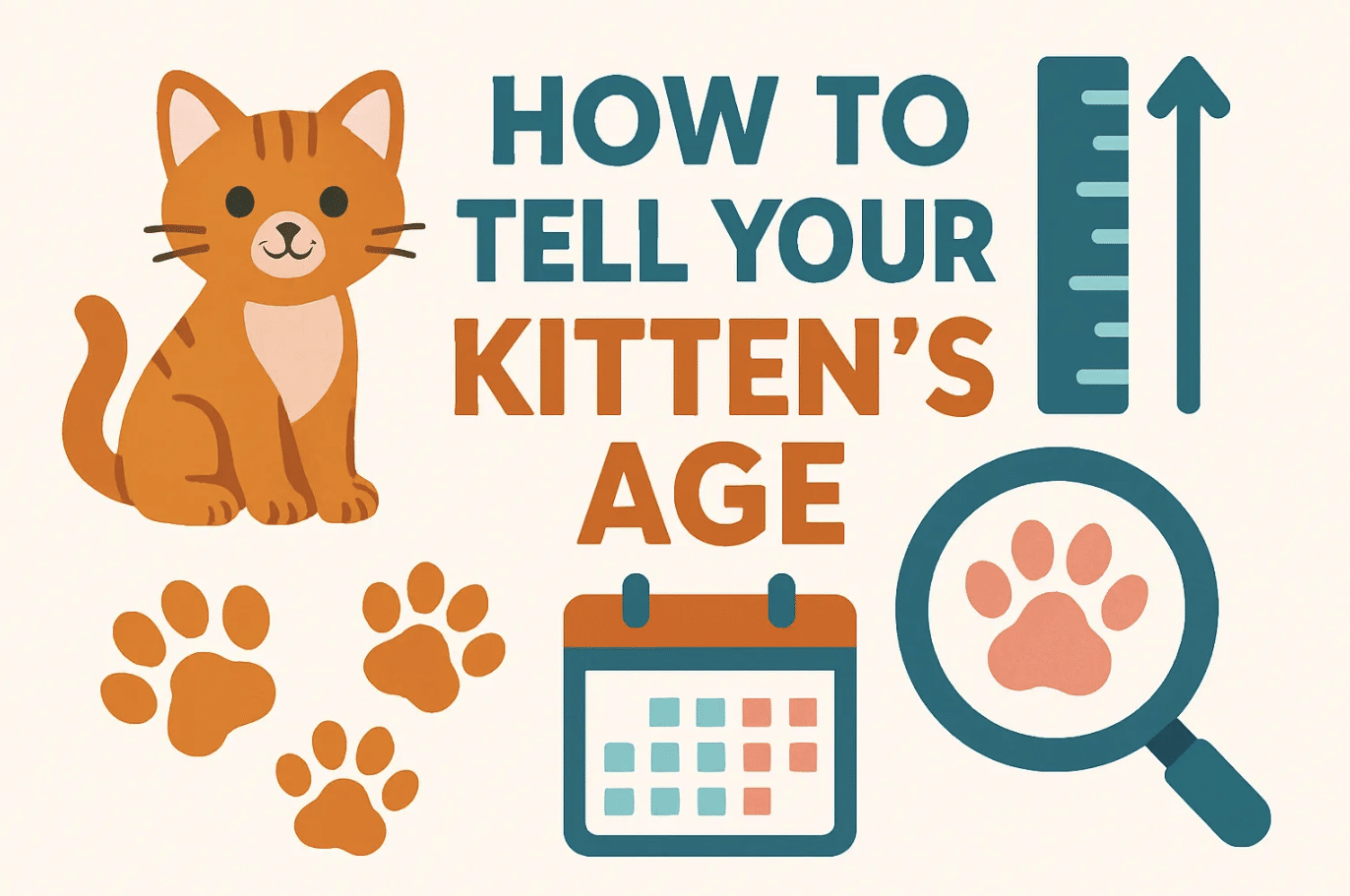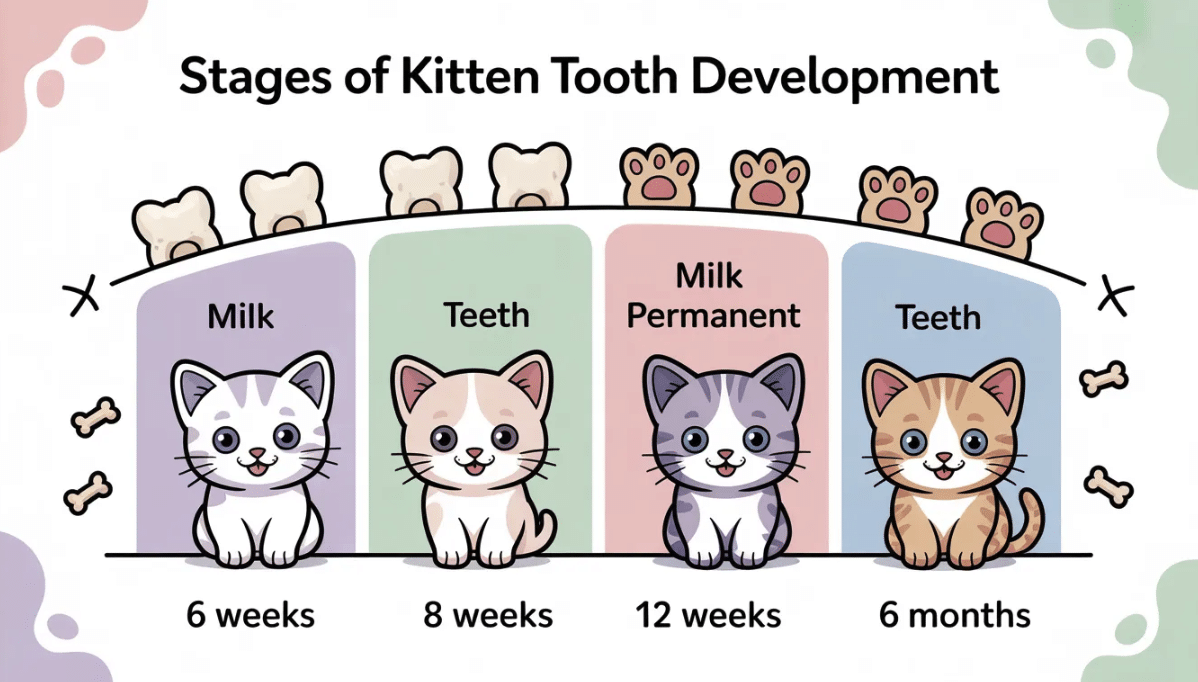
Ever wondered how to tell how old a kitten is? Determining your kitten’s age can feel like a mystery, but with the proper guidance, it will become easier. Knowing how to tell is helpful as it helps you provide the best care and nutrition tailored to their growth stage. A renowned expert, Doug Jimerson, emphasizes the importance of understanding these early days, from the first week to several weeks later, each stage reveals clues.
Let’s walk through a few kitten age determination methods.
Teeth Development
Deciduous Teeth
Timeline for Appearance
Kittens, like human babies, start with baby teeth. These are also known as deciduous teeth. Around the third week, you might notice the first signs of these tiny teeth. The incisors, those small teeth at the front, begin to emerge. By the fourth week, the canine teeth, the longer ones next to the incisors, start to appear. When your kitten reaches six weeks, the molars will begin to show up, completing the set of baby teeth. This timeline can help you estimate your kitten’s age accurately.
Here’s a quick reference table for the appearance of kitten teeth:
|
Age (Weeks) |
Teeth Development |
|---|---|
|
Incisors start to emerge |
|
|
4 |
Canine teeth begin to appear |
|
Molars start to develop |
|
|
8 |
Full set of baby teeth present |
How to Check for Teeth

Checking your kitten’s teeth is simple. Gently lift their lips to examine the gums. Look for the tiny white tips of the teeth emerging. If unsure, try comparing what you see with a kitten’s teeth chart. This can provide a visual guide to your kitten’s stage.
Permanent Teeth
Timeline for Appearance
As your kitten grows, those baby teeth will make way for adult teeth. This transition usually starts between three and four months of age. You’ll notice the adult teeth pushing out the baby teeth during this period. Your kitten should have a full set of adult teeth by six to seven months. These teeth appear wider and flatter compared to the sharpness of kitten teeth.
Identifying Permanent Teeth
Identifying adult teeth involves looking for these wider, flatter teeth. They replace the smaller, sharper baby teeth. You might even find a few baby teeth around the house, although kittens often swallow them. If you notice any discomfort or drooling, it could be a sign that your kitten is teething. This is a normal part of their development.
Recognizing the stages of tooth development assists in assessing your kitten’s age and guarantees appropriate care during these essential weeks. Monitoring their teeth will offer important insights into their growth process.
Weight and Size
Determining your kitten’s age through weight and size can be fun and insightful. I remember weighing Doofy and being amazed at how much information those numbers could reveal.
Average Weight by Age
Understanding the average weight of kittens at different ages can help you estimate their age more accurately. Here’s a handy weight chart that you can use as a reference:
|
Age (Weeks) |
Average Weight (Pounds) |
|---|---|
|
4 |
1 |
|
8 |
2 |
|
12 |
3 |
|
16 |
4 |
This chart provides a general guideline, but remember that individual kittens may vary. A 1-pound kitten is typically around 4 weeks old, while a 3-pound kitten is about 12 weeks old. These numbers can give you a ballpark figure to work with.
How to Weigh Your Kitten
Weighing your kitten is simple and can be done at home. Here’s how I do it:
-
Use a Kitchen Scale: Place a soft towel on the scale for comfort.
-
Gently Place Your Kitten: Ensure they are calm and still.
-
Record the Weight: Note the weight in pounds and compare it with the age chart.
Regularly weighing your kitten helps track their growth and ensures they are developing healthily.
Growth Patterns
Kittens grow rapidly; recognizing these growth patterns can provide additional clues about their age. Observing how quickly they change from week to week is fascinating.
Recognizing Growth Spurts
Kittens experience growth spurts, especially during the first few months. You might notice sudden increases in weight or size. These spurts often align with developmental milestones, such as transitioning to solid food or increased playfulness.
Comparing with Breed Standards
Different breeds have unique growth patterns. Comparing your kitten’s growth with breed standards can offer more precise insights. For example, larger breeds like Maine Coons may weigh more than the average kitten at the same age. Consulting a kitten age chart specific to your kitten’s breed can provide valuable context.
Understanding weight and size as indicators of age helps determine your kitten’s age and ensures they are on the right track for healthy development. Keep an eye on these factors, and you’ll better understand your kitten’s growth journey.
Eye and Ear Development
Understanding your kitten’s eye and ear development can offer valuable insights into their age. I remember the first time I noticed my kitten’s eyes changing color. It was a magical moment that marked a new stage in their growth.
Eye Color Changes
Timeline for Color Change
Kittens are born with their eyes closed, and they usually begin to open them around 8 to 12 days of age. Initially, all kittens have blue eyes. This color starts to change as they grow older, typically between 5 to 8 weeks. By the time they reach 12 weeks, most kittens will have developed their permanent eye color.
This transformation is fun to observe and can provide clues about their age.
Observing Eye Development
To observe your kitten’s eye development, gently hold them in a well-lit area. Look for any changes in color or clarity. They are likely under 8 weeks old if their eyes are still blue. As the weeks pass, you may notice subtle shifts in hue, indicating their progression toward adult eye color.
Keeping a close watch on these changes can help you pinpoint their age more accurately.
Ear Position and Function
Ear Development Stages
Kittens are born with their ears folded down, and they start to unfold around the same time their eyes open. By 2 weeks, their ears will begin to stand up, and they will start responding to sounds. Full hearing develops by 5 to 6 weeks. This progression in ear development is another indicator of their age.
Checking Ear Responsiveness
To check your kitten’s ear responsiveness, make a soft noise nearby and observe their reaction. A kitten that turns its head or perks up its ears is likely over 2 weeks old. As they grow, their hearing becomes more acute, and they will respond more actively to sounds. This responsiveness can help you gauge their age and ensure they develop normally.
Monitoring your kitten’s eye and ear development helps determine their age and ensures they are growing healthily. These small changes can reveal a lot about their journey from a newborn to a playful young cat. Keep an eye on these developments, and you’ll better understand your kitten’s growth.
Behavioral Indicators
Understanding your kitten’s behavior can offer valuable insights into their age and development. I remember watching my first kitten play and socialize, and it was a delightful experience.
Let’s find out how these behaviors can help you determine your kitten’s age.
Play and Socialization
Typical Behaviors by Age
Kittens exhibit different behaviors as they grow. During the first few weeks, they mostly sleep and nurse. Around 3 weeks of age, they start to become more active and curious.
By 4 to 5 weeks, you’ll notice them engaging in playful activities, such as batting at objects or pouncing on their littermates. This playfulness peaks between 3 to 6 months, as they explore their environment and learn new skills. According to a veterinarian, kittens misbehave most during this period as they actively play and explore.
Interaction with Littermates
Interaction with littermates is crucial for a kitten’s social development. They rely on each other in the early weeks for warmth and comfort. As they grow, they begin to play-fight and chase each other. These interactions help them learn important social skills, such as bite inhibition and appropriate play behavior.
Observing how your kitten interacts with its littermates can provide clues about its age and social development.
Independence Levels
Signs of Growing Independence
As kittens grow, they become more independent. Around 4 weeks of age, they start to explore their surroundings and show interest in solid food. By 8 weeks, they are more confident and may venture further from their mother. This growing independence is a sign that they are developing normally and can help you estimate their age.
Transition to Solid Food
The transition to solid food is another indicator of a kitten’s age. Around 4 to 5 weeks, kittens show interest in their mother’s food. By 7 weeks, they are usually fully weaned onto wet food. This transition marks an important milestone in their development and can help you determine their age.
Understanding these behavioral indicators helps determine your kitten’s age and ensures they are developing healthily. Keep an eye on their play and socialization patterns, and you’ll gain valuable insights into their growth journey.
Things Required
When I first started caring for kittens, I quickly realized that having the right tools made all the difference. Whether you’re a seasoned cat lover or a first-time kitten parent, gathering essential tools can simplify the process of determining your kitten’s age and ensuring their well-being.
Tools for Assessment
Having the right tools at your disposal can make assessing your kitten’s age much easier. Here’s what you’ll need:
Scale for Weighing
A reliable scale is crucial for tracking your kitten’s growth. I recommend using a digital kitchen scale, as it provides precise measurements. Weighing your kitten weekly helps monitor their development and ensures they’re on track with their growth milestones. Here’s a simple way to weigh them:
-
Prepare the Scale: Place a soft towel on the scale to keep your kitten comfortable.
-
Gently Weigh Your Kitten: Calmly place your kitten on the towel and note the weight.
-
Record the Weight: Keep a log of their weight each week to track progress.
Regular weighing is an important part of kitten care, helping you identify any potential health issues early on.
Reference Charts and Guides
Reference materials like the ASPCA Kitten Age Guide or a kitten age chart can be invaluable. These guides provide visual cues and detailed descriptions of developmental stages. They help you compare your kitten’s progress with typical milestones. I often refer to these charts to ensure my kittens are developing normally.
-
Kitten Age Chart: Offers a week-by-week breakdown of physical and behavioral changes.
-
Kitten Progression Guide: Provides insights into what to expect as kittens grow.
These resources are especially helpful if you’re caring for a rescued kitten with unknown age. They offer a roadmap to understanding your kitten’s needs at each stage.
Incorporating these tools into your routine not only aids in accurately determining your kitten’s age but also enhances your overall kitten care experience. With the right equipment and knowledge, you’ll feel more confident in providing the best care for your furry friend.
Pro Tips
Navigating the journey of kitten care can feel overwhelming, especially when trying to determine your kitten’s age. I remember the first time I tried to figure out how old my little Tweed was. It felt like a puzzle with so many pieces. But with some guidance and a few pro tips, you can make this process smoother and more enjoyable.
Consulting a Veterinarian
When to Seek Professional Advice
Sometimes, despite our best efforts, we might feel unsure about our kitten’s development. That’s when consulting a veterinarian becomes invaluable. If you notice any unusual behavior or health concerns, it’s crucial to seek professional advice. A veterinarian can provide insights that go beyond what we can observe at home. They can help identify any underlying issues that might affect your kitten’s growth.
Benefits of a Vet’s Assessment
A vet’s assessment offers several benefits. They can accurately determine your kitten’s age using their expertise and tools. They might even suggest implanting a microchip for identification, which is a common practice. This tiny implant ensures your kitten’s safety and helps track their medical history.
Regular check-ups also allow vets to monitor your kitten’s health and development, ensuring they grow into healthy adults.
Keeping a Growth Journal
Tracking Changes Over Time
Keeping a growth journal can be a fun and rewarding way to track your kitten’s development. I started one for my darling Wembley, and it became a cherished record of his early days.
Note down changes in weight, behavior, and milestones each week. This practice helps you spot patterns and identify any deviations from the norm.
Using Photos for Comparison
Photos are a powerful tool in your growth journal. Capture your kitten’s progress with weekly photos. Compare these images to see how they’ve grown and changed. It’s amazing to look back and see how much they’ve developed over the weeks. This visual record complements your written notes and provides a comprehensive view of your kitten’s journey.
Frequently Asked Questions
Navigating the world of kitten care can feel like a whirlwind, especially when you’re trying to determine their age. I remember the first time I had a litter of kittens, and I was constantly questioning if they were developing as they should. Let’s dive into some common questions that might be on your mind.
What if my kitten’s development seems off?
Worry is unnecessary if your kitten doesn’t follow the typical growth patterns. I once had a kitten that seemed smaller than its siblings, and it turned out to be perfectly healthy. However, if you notice significant deviations, it’s wise to consult a veterinarian. They can assess your kitten’s health and development more accurately.
Dr. Stephen Horvath, a renowned expert, mentions that determining a cat’s age without history can feel like a guessing game. Various methods, such as examining eyes, teeth, and organ function, are used, but no single attribute provides a definitive answer. If your kitten’s development seems off, a vet can perform tests to rule out any underlying health issues.
How accurate are these methods?
Estimating a kitten’s age involves a mix of observation and educated guesses. While methods like examining teeth and weight provide useful clues, they aren’t foolproof. For instance, a kitten’s weight can vary based on breed and nutrition. A 1-pound kitten might typically be around 4 weeks old, but this isn’t a strict rule.
Here’s a quick reference table to illustrate the variability in kitten growth:
|
Age (Weeks) |
Average Weight (Pounds) |
Teeth Development |
Eye Color |
|---|---|---|---|
|
2 |
0.5 |
Eyes opening |
Blue |
|
4 |
1 |
Incisors emerging |
Blue |
|
8 |
2 |
Full set of baby teeth |
Changing |
|
12 |
3 |
Permanent teeth appearing |
Permanent |
These methods offer a general guideline, but individual kittens may develop at their own pace. If you’re ever in doubt, consulting a veterinarian can provide a more precise assessment. They have the expertise and tools to evaluate your kitten’s age more accurately.
Understanding these FAQs can help ease your concerns and guide you in providing the best care for your kitten. Remember, each kitten is unique, and their journey is special. Enjoy every moment with your furry friend, and don’t hesitate to seek professional advice.
Estimating your kitten’s age can be rewarding. Key indicators include teeth development, weight, and behavior. For kittens up to 10 weeks, body weight predicts age. Beyond that, consider other factors for precision. Enjoy every moment with your furry friend. New kitten owners may find the ASPCA Kitten Age Guide invaluable.
Remember, each week brings new discoveries and joys as you watch your kitten grow and thrive.

In her previous life, Lisa traveled extensively, both for work and leisure. After the pandemic struck, Lisa locked up her luggage and adopted a cat ever since.
Lisa is now an avid cat lover, she devotes most of her free time serving as butler to her adorable feline at home. When she is not with her cat, she can be seen using her phone sourcing for the latest cat supplies online.


